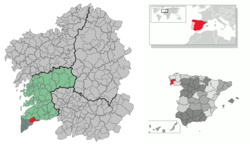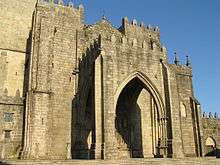Tui, Pontevedra
Tui (Galician pronunciation: [ˈtuj]) is a municipality in the province of Pontevedra in the autonomous community of Galicia, in Spain. It is situated in the comarca of O Baixo Miño. It is located on the right bank of the Miño River, facing the Portuguese town of Valença.
Tui | |
|---|---|
View of Tui | |
 Flag  Coat of arms | |
 Situation of Tui within Galicia | |
| Coordinates: 42°2′53″N 8°38′40″W | |
| Country | Spain |
| Autonomous Community | Galicia |
| Province | Pontevedra |
| Comarca | O Baixo Miño |
| Parroquias | List
|
| Government | |
| • Type | Concello |
| • Mayor | Carlos Vázquez Padín (C21) |
| Area | |
| • Total | 68.3 km2 (26.4 sq mi) |
| Elevation | 44 m (144 ft) |
| Population (2018)[1] | |
| • Total | 16,902 |
| • Density | 250/km2 (640/sq mi) |
| Time zone | UTC+1 (CET) |
| • Summer (DST) | UTC+2 (CET) |
| Post code | 36700 |
| Area code(s) | +34 986 |
| Website | Official website |
Two bridges connect Tui and Valença: Tui International Bridge (known in Portugal as Valença International Bridge), completed in 1878 under the direction of Pelayo Mancebo, and a modern one from the 1990s. Both countries being signatories of the Schengen Treaty, there are normally no formalities in crossing what is the busiest border-point in Northern Portugal. The municipality of Tui is composed of 11 parishes: Randufe, Malvas, Pexegueiro, Areas, Pazos de Reis, Rebordáns, Ribadelouro, Guillarei, Paramos, Baldráns and Caldelas.
History

Prehistory
The Tui area was inhabited since prehistoric times. Evidence of this are the sites found during construction of the highway Vigo-Tui, on the border with Porriño, dating from the Lower Paleolithic period which was the oldest in Galicia.
The fertile valley of the Minho and its magnificent natural conditions allowed the Tudense territory to accommodate human settlement from the earliest times. The vestiges are from the Palaeolithic period (20,000 BC) in the fluvial terraces of the river Minho and Louro and from the Neolithic period (5,000 BC) are the Carrasqueira ax or megalithic monuments (Anta - Areas). The introduction of metallurgy (4,000 BC) left testimonies like the helmet of bronze Caldelas axes (now in the Tudense Diocesan Museum) or engravings of Randufe.
Middle Ages
Its original local name, Tude, was mentioned by Pliny the Elder and by Ptolemy in the first century AD. It became an episcopal see no later than the 6th century, during the Suevic rule, when Bishop Anila went to the II Council of Braga. Later, in the Visigothic period, it briefly served as the capital of a Galician subkingdom under king Wittiza. After the campaigns of Alfonso I of Asturias (739–757) against the Moors, the town lay abandoned in the largely empty buffer zone between Moors and Christians, being later part of the "Repoblación" (repopulation) effort carried out a century later, during the reign of Ordoño I of Asturias (850–866). In the 10th century, it was raided by Vikings,[2] being abandoned and later re-established in its current location. Today the town centre is near the Inn of San Telmo. On the top of the hill, the cathedral (11th–13th century) preserves Romanesque elements in its main vestibule, and the Gothic period in the western vestibule. The town has two museums, one dedicated to archaeology and sacred art, and the other is the diocesan museum.
Economic and productive activity
The industry in the city of Tui is gradually gaining weight, as the construction of industrial estate areas as many national and international companies have established a production facility there. Yet the industry is not more than 20% of GDP in the city.
Construction one of the fastest growing sectors of Tui, estimated at 4.2% in 2005. The trend shows an increase in residential construction, driven by the slight slowdown in the increase of the cost of living.
Politics
| Local election results in Tui | ||||||||||||||||
|---|---|---|---|---|---|---|---|---|---|---|---|---|---|---|---|---|
| Party | 2007 | 2011 | 2015 | |||||||||||||
| People's Party (PP) | 7 | 9 | 4 | |||||||||||||
| Spanish Socialist Workers' Party (PSOE-PSdeG) | 6 | 4 | 3 | |||||||||||||
| Converxencia Vinteún (C21) | - | 1 | 2 | |||||||||||||
| Alternativa Tudense (AT) | 4 | 3 | 2 | |||||||||||||
| Galician Nationalist Bloc (BNG) | 2 | 2 | 2 | |||||||||||||
| Ciudadanos Tudenses (CsT) | - | - | 2 | |||||||||||||
| Son de Tui (SON) | - | - | 1 | |||||||||||||
| Tui Popular Alternative (APTUI) | - | - | 1 | |||||||||||||
References
- Municipal Register of Spain 2018. National Statistics Institute.
- Fletcher, R.A. (1984). Saint James's catapult : the life and times of Diego Gelmírez of Santiago de Compostela. Oxford: Clarendon Press. p. 23. ISBN 978-0-19-822581-2.
| Wikimedia Commons has media related to Tui. |